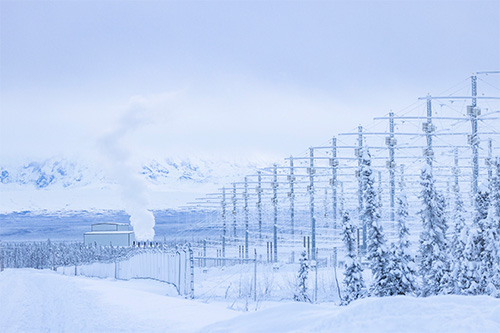HAARP (High-frequency Active Auroral Research Program) research facility at Gakona, Alaska. |
“We will be analyzing the data over the next few weeks and hope to publish the results in the coming months,” said Mark Haynes, lead investigator on the project and a radar systems engineer at NASA’s Jet Propulsion Laboratory in Southern California. “This experiment was the first time an asteroid observation was attempted at such low frequencies.
“This shows the value of HAARP as a potential future research tool for the study of near-Earth objects,” he said.
Several programs exist to quickly detect asteroids, determine their orbit and shape and image their surface, either with optical telescopes or the planetary radar of the Deep Space Network, NASA’s network of large and highly sensitive radio antennas in California, Spain and Australia.
Those radar-imaging programs don’t provide information about an asteroid’s interior, however. They use signals of short wavelengths, which bounce off the surface and provide high-quality external images but don’t penetrate an object.
Long wavelength radio signals can reveal the interior of objects.
HAARP, using three powerful generators, began transmitting chirping signals of long wavelength at 2 a.m. Tuesday and continued sending them uninterrupted until the scheduled end of the 12-hour experiment.
The University of New Mexico Long Wavelength Array near Socorro, New Mexico, and the Owens Valley Radio Observatory Long Wavelength Array near Bishop, California, are also involved in the experiment.
Data analysis is expected to take several weeks.
The Tuesday experiment also served as a test for probing an asteroid larger than 2010 XC15.
Asteroid Apophis, discovered in 2004, will make its closest approach to Earth on April 13, 2029. It will come within about 20,000 miles of Earth, closer than the many geostationary satellites orbiting the planet.
Apophis, which NASA estimated to be about 1,100 feet across, was initially thought to pose a risk to Earth in 2068, but its orbit has since been better projected by researchers and is now not a risk to the planet for at least a century.
Tuesday’s test follows tests in January and October in which scientists bounced long-wavelength signals off the moon in preparation for this week’s experiment.
Haynes said understanding the makeup of an asteroid’s interior, especially of an asteroid large enough to cause major damage on Earth, can increase the chances of an effective defense. Knowing the distribution of mass within a dangerous asteroid could help scientists target devices designed to deflect an asteroid away from Earth.
Amateur scientists from around the world reported receiving the outgoing transmission, said Jessica Matthews, HAARP’s program manager. The reports will help infer the conditions of the ionosphere during the experiment.
“Our collaboration with JPL is not only an opportunity to do great science but also involves the global community of citizen scientists,” she said. “So far we have received over 300 reception reports from the amateur radio and radio astronomy communities from six continents who confirmed the HAARP transmission.”
The University of Alaska Fairbanks operates HAARP under an agreement with the Air Force, which developed and owned HAARP but transferred the research instruments to UAF in August 2015.
On the Web:
HAARP to bounce signal off asteroid in NASA experiment By ROD BOYCE
SitNews - December 24, 2022
This article is provided as a public service by the University of Alaska Fairbanks' Geophysical Institute. Rod Boyce [rcboyce@alaska.edu] is a science writer with the Geophysical Institute. |
Representations of fact and opinions in comments posted are solely those of the individual posters and do not represent the opinions of Sitnews.
Send a letter to the editor@sitnews.us
SitNews ©2023
Stories In The News
Ketchikan, Alaska
Articles & photographs that appear in SitNews are considered protected by copyright and may not be reprinted without written permission from and payment of any required fees to the proper freelance writers and subscription services.
E-mail your news & photos to editor@sitnews.us
Photographers choosing to submit photographs for publication to SitNews are in doing so granting their permission for publication and for archiving. SitNews does not sell photographs. All requests for purchasing a photograph will be emailed to the photographer.

